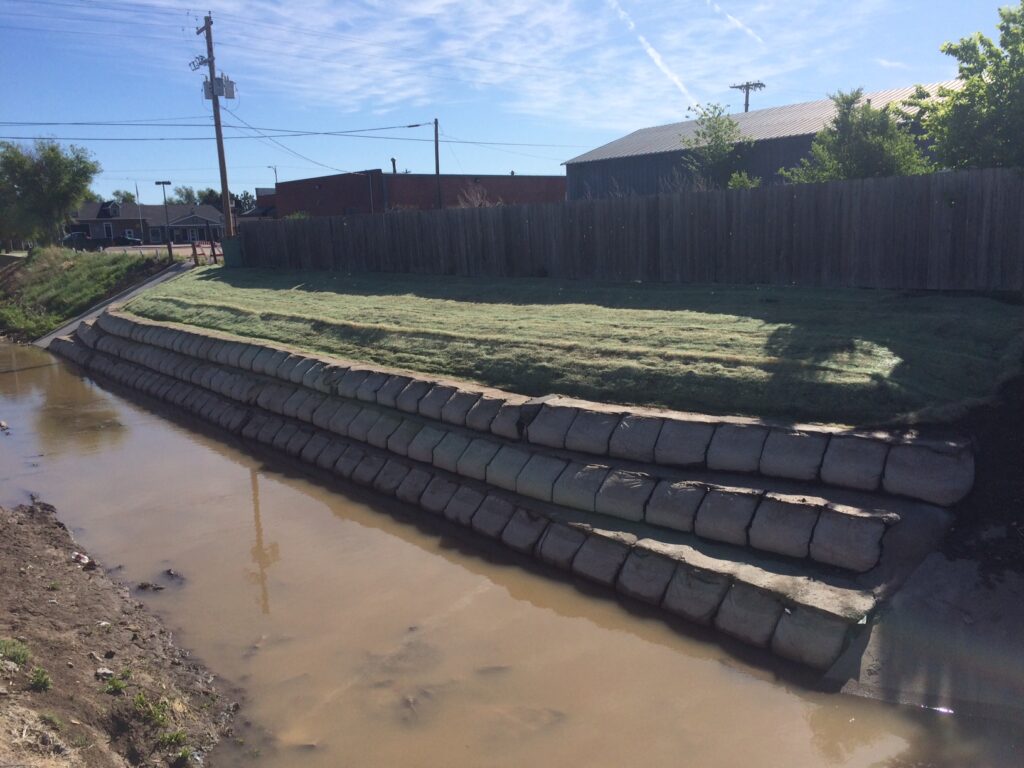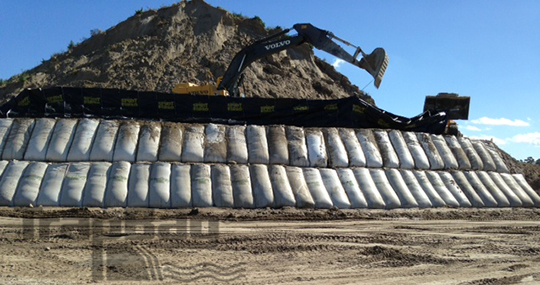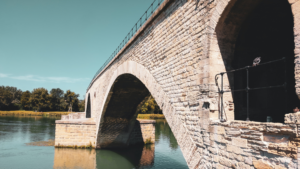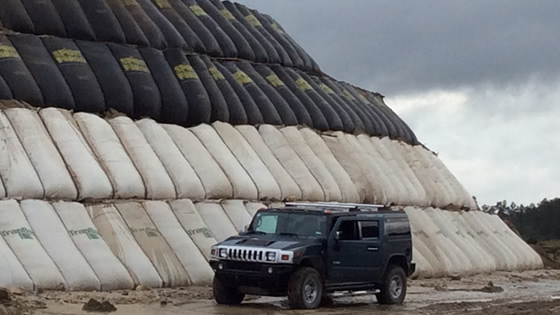MSE Walls for Bridge Abutments
Learn how mechanically stabilized earth (MSE) walls are a great solution to constructing bridge abutments. Use TrapBags to build your next MSE wall.

Mechanically stabilized earth (MSE) walls are easy to create with plenty of designs from which you can choose. This complex array of MSE wall designs and economic advantages makes MSE an attractive style of construction for different applications, including bridge abutments.
MSE Walls (mechanically stabilized earth walls)
Mechanically stabilized earth walls are a form of retaining wall. They are made from compacted soil and backfill, usually fixed to a wall facing as a form of support to prevent erosion. MSE walls are complex structures and the MSE wall components include several layers of solid backfill and soil support elements that enable them to withstand and retain the effect of gravity.
The soil backfill forms a strong soil mass alongside the soil support, which attaches to the facing elements. The wall-facing elements help prevent erosion of the backfill, which further improves the structure’s integrity.
Mechanically Stabilized Earth Walls or reinforced earth walls can withstand extremely harsh weather and environmental conditions. Such conditions include a water surge, lateral earth pressures, or seismic events. They are strong and durable. They can also withstand the effects of man-made creations on them.
Mechanically Stabilized Earth For Bridges refers to a type of engineered fill used to support bridge structures especially bridge abutments (the supports at the ends of a bridge span). It’s a system that uses layers of soil reinforced with horizontal inclusions like steel strips, geosynthetic materials (such as geogrids), or meshes to create a strong and stable mass.
What is a Bridge Abutment?
Bridge abutments provide support to a bridge. They attach to the bridge ends to ensure that the bridge superstructure has significant building integrity. Not only do they give integrity to the superstructure, but they also maintain the base material of the roadway while linking the bridge to the roadway. The primary function of the bridge abutments is to spread the weight of the bridge and support its load.
The foundation of the MSE abutments must be large, strong, and heavy to bear the weight of the abutment and the eventual weight of the bridge deck. They must also withstand the high pressure of water and soil, depending on their installation site.
Purposes of Bridge Abutments
Bridge abutments have a daring role to play in the construction of bridges. Their instrumental role ensures that the integrity of many bridges is the same many years after their construction. Bridge abutments help to:
Transfer Loads
They help to spread out the weight of the bridge, transferring the overall load so that the bridge can go the distance and not crash.
Resist Loads
They also resist the effect of heavy loads and pressures with the help of their strong and large foundation.
Support a Slab
Not only do they transfer a load or resist its effects, but they also act as a support to the bridge slab resting directly on them.
Balance Forces
They also help the bridge’s weight balance with forces on and off the bridge, which helps maintain the bridge’s integrity for a long time to come.
Bridge Abutment Components
Abutments can be at the endpoints of bridges and along a bridge’s span. Those at the ends have all of the components below, however, those along the span of the bridge do not have the wing walls and the back walls.
Bridge Seat
Bridge seats are horizontally-shaped structures that are always close to the top or on the top of the abutment. Its purpose is to support the bridge deck. Bridge seats are at the ends of a bridge and along its span, making sure to reduce the stress exerted by the bridge and holding it aloft.
Backwalls
Backwalls do not constitute the span of a bridge. Instead, they are part of the components at the end. They form a bridge brace from the deck and prevent erosion at the endpoints of the bridge.
Wing Walls
Also not included among the components that constitute the span of the bridge, wing walls prevent erosion and stabilize the bridge at its ends.
Pile
A pile can be a row of several columns or a single wall, and its purpose is to connect the seat of the bridge with the foot of the bridge. Piles are components that you will find at the ends and along the bridge’s span.
Footing
Usually buried deep into the earth, the bridge’s footing connects the pile to the ground. It is a wide, horizontal structure that also helps to spread the weight of the bridge.
Constructing Bridge Abutments With MSE Walls
MSE Walls are often used to construct bridge abutments due to their strength and reliability. Building contractors prefer MSE walls to concrete walls because they can ‘withstand differential settlements without structural distress.’ Basically, they provide better support when compared to their concrete counterparts.
Advantages of Using MSE Walls for Bridge Abutments
Some of the advantages of constructing with a reinforced MSE wall include:
- They are quicker to install than their concrete counterpart
- They are also easier to install than their concrete counterpart
- They do not cost a lot of money, unlike the concrete-installed bridges
- You do not need to invest a lot of time and effort to prepare the site.
Alternative to Concrete
MSE Walls are a better alternative to concrete materials. They do not show structural distress under differences in load. Another advantage is that differential settlements are insignificant when you compare them to concrete bridge abutments.
Considerations When Building an MSE Bridge Abutment
Before you build your bridge abutment wall with MSE Walls, you should consider these factors:
- Cladding: as this will be the outward-facing element of the wall, you need to determine how you want it to look, all without compromising the stability of your wall.
- Reinforcement: different reinforcements do different things. Some are permanent, like steel or wire mesh, while others are temporary. Regardless, these must bond with the backfill for stability.
- Proper Foundation: the foundation must be level before you begin construction.
- Backfill Soil: This must be the right kind of soil for the backfill. It needs to be sturdy but allow for plasticity.
- Drainage: If you don’t account for drainage, your wall may quickly become water-logged and collapse.
Always inspect and verify that these factors are exactly right to prevent any problems while building.
TrapBags for MSE Wall Bridge Abutments
Building a retaining wall the conventional way can be pretty challenging. However, you can make things easy for yourself with TrapBag control bags, which are used the same way building contractors would use sandbags or concrete bags. TrapBags control erosion and flooding with their specially designed barriers that withstand the toughest projects while being cost-effective and easy to install. Made from heavy-duty geotextile, TrapBags stand four feet tall and can be connected to create a wall of any length, which is excellent for MSE wall construction for bridge abutments.
FAQs
How are bridge supports constructed in water?
Water bridge supports require a concrete foundation of sinking caissons stuck into the riverbed. They also require anchorages to which the cables of the bridge will connect. Once the cables attach, you will hang the bridge’s suspenders and then the deck.
What are all the types of bridge abutments?
Different types of bridge abutments include Gravity Abutment, U-shaped Gravity Abutment, Cantilever Wall Abutment, Full Height Abutment, Stub Abutment, Semi-stub Abutment, Counterfort Abutment, Spill-Through Abutment, and MSE SystemPile Bent Abutments.
What else can MSE walls be used for?
Apart from bridge abutments details, MSE walls are useful as retaining walls, seawalls, and dikes.
Conclusion
MSE walls are a great construction choice for bridge abutments because of their strength and durability. Consider utilizing a TrapBag MSE wall for your bridge construction. Learn more about TrapBags for MSE wall construction by browsing our products or contacting us today to get your bridge abutment project started.[/vc_column_text][/vc_column][/vc_row]
Get the Dirt Before the Flood Hits
Stay ahead of flooding, erosion, and disaster response challenges. The Dirt, TrapBag’s monthly newsletter, delivers field-tested tips, real-world case studies, and the latest in barrier technology straight to your inbox.



